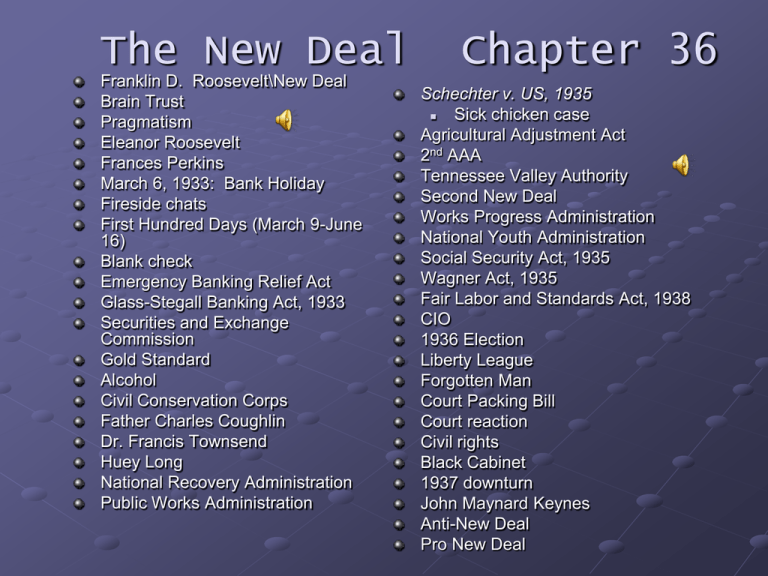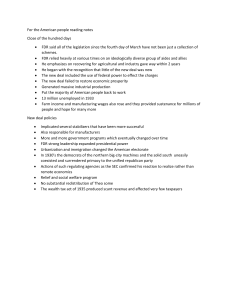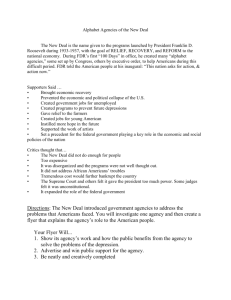PPT 25 New Deal
advertisement

The New Deal Franklin D. Roosevelt\New Deal Brain Trust Pragmatism Eleanor Roosevelt Frances Perkins March 6, 1933: Bank Holiday Fireside chats First Hundred Days (March 9-June 16) Blank check Emergency Banking Relief Act Glass-Stegall Banking Act, 1933 Securities and Exchange Commission Gold Standard Alcohol Civil Conservation Corps Father Charles Coughlin Dr. Francis Townsend Huey Long National Recovery Administration Public Works Administration Chapter 36 Schechter v. US, 1935 Sick chicken case Agricultural Adjustment Act 2nd AAA Tennessee Valley Authority Second New Deal Works Progress Administration National Youth Administration Social Security Act, 1935 Wagner Act, 1935 Fair Labor and Standards Act, 1938 CIO 1936 Election Liberty League Forgotten Man Court Packing Bill Court reaction Civil rights Black Cabinet 1937 downturn John Maynard Keynes Anti-New Deal Pro New Deal FDR: What do we have to fear? Served from (193345)….only president elected 4 times Your cheating heart…… In 1918, Eleanor discovers her husband's affair with Lucy Mercer. Hurt and betrayed, she offers Franklin a divorce. He declines, but they are never again truly a married couple . In the wake of this devastating event, Eleanor decides to take up her social work again. Ironically, this helped lead Eleanor to search for new avenues for expressing her emotions and keeping herself occupied. Thus, she became one of the most vocal, active, and admired first ladies in U.S. history. Polio FDR seemed to represent the poor and Hoover the rich Brain Trust He created a Brain Trust to help him which was a group of professors of economics, etc. to help figure out how to get out of the depression This was his own kitchen cabinet The depression was getting worse after FDR was elected in Nov. because he had to wait until March to take office In 1933 the time of taking the Presidency was changed to January with the 20th Amendment Pragmatism FDR believed in the idea of pragmatism: value of an idea..try something whether it works or not, but try something! Proposed by philosopher William James Women who helped FDR His wife, Eleanor, traveled the country to find out what people needed and wanted, reactions to changes, etc. Frances Perkins was the first woman cabinet member: Sec. Of Labor A Pender County community designed by the federal government to be self-sufficient during the Great Depression is working together again to preserve its history. Penderlea was created in the early 1930s through one of President Franklin Roosevelt's New Deal programs,. Residents in the community raised crops and livestock they needed to stay alive. The community's history dates back to 1933, when the federal government bought 4,500 acres for $29,500. About $1 million for the community's development came from the Subsistence Homestead Act, designed to develop self-sufficient communities and ease the burden on overpopulated cities. Penderlea's most famous visitor may have been Eleanor Roosevelt, who came to town on June 11, 1937. Penderlea residents leased their homes from the federal government for $60 a year until the 1940s, when they began buying their houses. Of 300 homes built there when the homestead was formed, about 100 remain. Bank Holiday and Encouragement FDR ordered a bank holiday in his first days as President Banks would be closed and reorganized and evaluated; also to keep people from taking their money out This was drastic, but effective Fireside Chats He then went over the radio (he did this soooo well!!) to talk to the American people (fireside chats) to put their money back into the banks and assured them it would be safe Over the next few weeks, billions of dollars came back into the banks The New Deal had begun with a success! First Hundred Days The first hundred days (also called the First New Deal) saw more legislation passed in a few months than Congress usually passed in 2 years Passage of New Deal legislation; lots of acts These relief efforts were controlled by Congress The First New Deal called for relief and recovery Money through work; not handouts March 9-June 16 Blank Check Congress seemed to have a rubber stamp to push through FDR’s legislation A blank check was given to FDR from Congress Some powers of the legislative branch given to the executive branch Pre New Deal Before FDR had initiated his ideas, many states had already begun to pass similar legislation Many western European countries saw the US as backwards in the area of social welfare Emergency Banking Relief Act, 1933 President has power to regulate banking transactions and foreign exchange Glass-Stegall Banking Act Created the FDIC Federal Deposit and Insurance Corporation to insure funds in banks Up to $5000.00 at first SEC Securities and Exchange Commission was set up to regulate the stock market It was headed by Joseph Kennedy Part of first New Deal (1933) Gold Standard FDR wanted all gold surrendered to the Treasury in exchange for paper money Took the nation off the gold standard Cause inflation Paper money wasn’t redeemable in gold any longer Returned to gold standard in 1934 Gold coins became collectors items Alcohol Beer and Wine Revenue Act: legalize beer and wine Why? Prohibition repealed by the 21st Amendment TAXES! More Alphabet Legislation Civil Conservation Corps was set up to provide jobs by planting trees, control flood and soil erosion; to prevent another Dust Bowl Over 3 million people were put to work Low pay, free food and a uniform….it was a job! American Experience Begun during the administration of President Franklin D. Roosevelt, the project was originally called the "Appalachian Scenic Highway". Work began on September 11, 1935 and took over fifty-two years to complete, the last stretch (near the Linn Cove Viaduct) being laid around Grandfather Mountain in 1987. Jobs of the CWA and living areas of the CCC CCC Camp Playground instructions Encourage Rural people to read Colored barracks Radical Left Opponent Father Charles Coughlin Used radio to spread his idea of Social Justice Had huge audiences until his anti-Semitism and fascism appeared Dr. Francis Townsend Retired physician who lost his savings Senior citizen retirement system 60 and older got $200 a month Had to spend it all that month Promote spending\economy Every Man A King Rep v Dem Huey Long Opponent from the radical left Among them was Huey Long Governor of Louisiana Nicknamed the Kingfish (Long’s Platform) Share the Wealth program: a type of welfare in which each person would get $5000 a year, division of land, etc. The infrastructure was built up Made many enemies on his way to power He was FDR’s most serious threat for reelection in 1936 Long was assassinated in 1935 at the Louisiana State House National Industrial Recovery Act Created the NRA (National Recovery Admin.) to set up industry codes of business to control child labor, eliminate unfair business practices, set minimum wages, etc. It also helped to limit production so producers would make a profit Some had the symbol in their business, but didn’t follow the rules PWA Public Works Administration which used the idea of priming the pump: spend money to create jobs Thousands were put to work building bridges, hospitals, airports, etc. Schechter v. US, 1935 Sick chicken case Congress couldn’t delegate legislative power to the executive branch Agricultural Adjustment Act (AAA) Paid farmers to plant less and destroy some crops they already had to raise prices It worked as prices did slowly rise, but also led to unemployment Hog farmers were paid to slaughter 6 million hogs Many upset at the waste, but prices rose and farmers were happier Challenges to the New Deal in the Courts Some didn’t like the power of the New Deal and the AAA and the NRA would be challenged in court and overturned Some said FDR did too much, others said too little The NRA was declared unconstitutional saying it gave legislative powers to the executive It was reworded and renamed by Congress and two new acts were passed The AAA was also challenged and more power was given to the states in regulating farmers Challenges to the AAA The AAA was challenged in the Supreme Court also and had to be reorganized The new 2nd AAA called for parity Crops would no longer be destroyed, but stored until they reached parity (a set price) and then the crops would be sold and farmers could pay their debts Tennessee Valley Authority This was one of the most longest lasting parts of the New Deal It effected a 7 state area and led to the construction of dams, power plants, created jobs, fought erosion It improved living conditions and the economy in this area Some people were upset at the federal government for trying to compete with private industry, but many in rural areas were happy to have jobs and electricity; neither of which they had before Who controlled this relief effort? It would also be used as a yardstick to measure fair prices for electricity TVA The Second New Deal begins 1934 The first New deal had put 4 million people to work, but that still left 10 million unemployed In 1934 the Democrats gained power in Congress and began to help FDR employ this Second New Deal which focused on reform When a man is getting over an illness, wisdom dictates not only cure of the symptoms, but removal of their cause Works Progress Administration Headed by Harry Hopkins Create as many jobs as possible as quickly as possible From 1935-41 an average of 2 million jobs a year were filled building bridges, airports, schools, washing govt. buildings, sweeping pigeon droppings, sewing garments for the needy, etc. WPA: The Arts The most controversial part of the WPA was the funding of artists, theaters, etc. Many felt the money could be better spent elsewhere 20% of the WPA budget went here It paid composers, artists to paint murals, give free concerts, free plays, etc. Why was this important? National Youth Administration Set up to provide children with aid and employment Provided organized sports, etc. Black and white divisions of the NYA Social Security Social Security Act, 1935 was passed as a pension for retired workers, unemployment systems, disabled It had the greatest impact on the average citizen Congress Reorganization Wagner Act, 1935 After the NIRA (NRA) was deemed unconstitutional, it was reorganized by Congress Wagner Act: National Labor Relations Act Listed unfair business practices Union use of collective bargaining National Labor Relations Board (heard worker’s grievances) Govt. on the side of unions Fair Labor and Standards Act, 1938 National minimum wage and work week .25 to .40 an hour 44 to 40 hours a week No one under 16 in factories First time a national minimum wage was set New Deal allowed unions to grow No reforms in health insurance Unions made gains during the New Deal Committee for Industrial Organization Not like the AFL Allowed unskilled workers Allowed minorities Used sit-down strikes Merged with the AFL in 1955 1936 Election Blacks begin to vote democrat Why? Republicans began to challenge New Deal legislation FDR would win the election Liberty League Wealthy Republicans and Conservative Democrats to fight socialist New Deal legislation Alfred Landon and the Republicans won only 2 states Democrats retained a majority in Congress FDR won support from the “Forgotten Man” Those who received jobs through the New Deal Don’t bite the hand that feeds you “No one shoots Santa Clause” Much support from new immigrants, Jews, Catholics Court Packing Bill Some saw it as a violation of checks and balances Who would appoint them? Why would he want to do this? In 1937, FDR attempted to reorganize the Supreme Court by adding more judges He wanted to pass a law that would allow him to appoint a new justice for everyone on the bench currently over 70…new blood Falsely accused the court of falling behind on their work Results Court packing failed and turned some against FDR Some see it as an attempt at dictatorship by FDR FDR eventually appointed 7 new justices Results of the Court Packing Little New Deal legislation passed after 1937 Republicans gained more seats in Congress Civil Rights FDR was never fully behind civil rights Needed Southern Democratic support Many blacks did benefit from New Deal jobs and other legislation Black Cabinet FDR did value his Black Cabinet Black leaders who advised FDR on black issues and problems; advised in racial issues One of the main organizers was Mary McLeod Bethune Even though D.C. was a Jim Crow town, the Roosevelt’s didn’t show it; inviting black leaders to the White House for dinner, etc. Marion Anderson was refused the right to sing at Constitution Hall by one group in D.C. and Eleanor Roosevelt let her sing at the Lincoln Memorial instead She was a famous opera singer at the time Other minorities made gains: Hispanics, Indians (gained citizenship in 1924) 1937 Downturn The New Deal didn’t get rid of the depression (1933-37) but was relieved until 1937 The downturn was somewhat caused by New Deal policies Social Security tax Cut back on govt. spending Trying to keep a balanced budget John Maynard Keynes English economist Running on a deficit is ok! It was like priming the pump Anti New Deal Too socialist Wasteful Contradicting Crackpot professors Debt increased 19 to 40 billion in 7 years Didn’t end the depression Expanded the bureaucracy Less govt. interference in business Pro New Deal First time the federal govt. took responsibility for economic well being of its citizens Expanded the power of the federal govt. Built the infrastructure of the US Avoided collapse of the capitalist system in the US Reform without rebellion or revolution FDR was attacked from the left for not being liberal enough and from the right for being too liberal •In the 1936 Berlin Olympics, he won four gold medals: •100 meter dash in 10.3 seconds (tying the world record) •long jump with a jump of 26' 5 1/4" (Olympic record) •200 meter dash in 20.7 seconds (Olympic record) •400 meter relay (first leg) in 39.8 seconds (Olympic and world record) •Showed Nazi Germany and Hitler that they were not the “supreme race”.





